The creative landscape of film and television is experiencing a technological revolution. Artificial intelligence, once confined to technical industries, has found its way into the writer’s room. Today’s screenwriters are increasingly turning to AI tools like ChatGPT to overcome creative blocks, streamline workflows, and explore new narrative possibilities. This shift represents not just a change in tools, but a fundamental reimagining of the creative process itself.
As AI capabilities expand, the relationship between human creativity and machine assistance raises fascinating questions about the future of storytelling. In this article, we’ll explore how AI is being integrated into scriptwriting, examine real-world applications, and consider both the opportunities and challenges this technology presents to the film and television industry.
AI in Action: How ChatGPT Is Being Used in Film and TV
The integration of AI in scriptwriting isn’t just theoretical—it’s happening now across the industry. From independent filmmakers to major studios, creative professionals are finding innovative ways to incorporate tools like ChatGPT into their workflow. Here are some notable examples of AI’s application in scriptwriting:
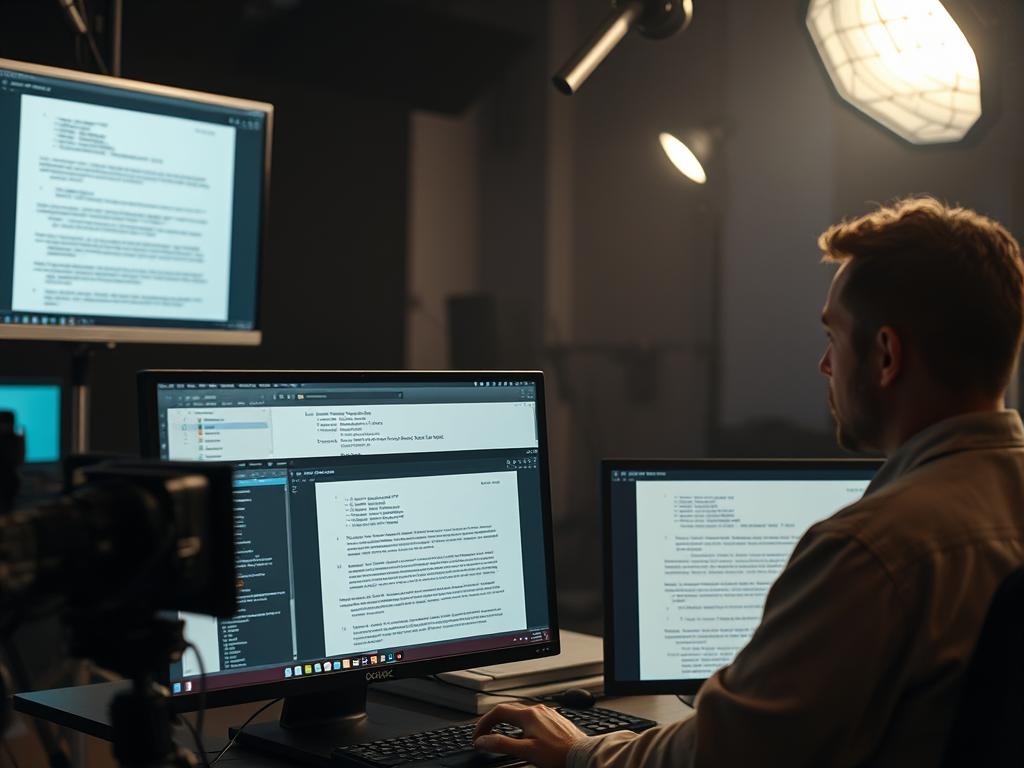
AI can generate multiple dialogue options for writers to consider
Dialogue Generation and Refinement
Writers are using ChatGPT to generate alternative dialogue options when they feel stuck. Director Alex Garland, known for his work on AI-themed films like “Ex Machina,” has experimented with AI tools to develop more nuanced conversations between characters.
“Sometimes you need a different perspective on how a character might express themselves,” notes screenwriter Maria Johnson. “I’ll ask ChatGPT to generate five different ways a character might respond in a scene, and while I rarely use the exact wording, it often sparks ideas I wouldn’t have considered.”
Character Development and Backstory Creation
AI tools excel at generating detailed character profiles and backstories. Writers feed ChatGPT basic character traits and receive expanded histories, psychological profiles, and potential character arcs in return.
Showrunner David Chen explains: “For supporting characters especially, ChatGPT helps me develop rich backgrounds quickly. I might not use every detail, but it creates a more three-dimensional understanding that influences how I write them.”

AI can help develop detailed character profiles and backstories
Plot Structure and Story Brainstorming
When facing writer’s block, screenwriters are turning to AI to generate plot outlines, identify potential story holes, or suggest unexpected narrative twists.
“I was stuck on a third-act problem,” shares independent filmmaker Rebecca Torres. “I described the situation to ChatGPT, and while its direct suggestions weren’t quite right, the conversation helped me see the issue from a different angle. The solution came from that dialogue.”
Research Assistance and World-Building
For scripts requiring specialized knowledge or elaborate fictional worlds, AI serves as a research assistant, providing writers with relevant information and helping to maintain consistency in complex narratives.
Science fiction writer Marcus Webb notes, “When creating a near-future technology thriller, I used ChatGPT to explore potential technological developments and their societal implications. It helped me build a more plausible world without spending weeks on research.”
Master AI Scriptwriting Techniques
Get our comprehensive guide on integrating AI tools into your scriptwriting process. Learn practical techniques used by professional screenwriters to enhance creativity without sacrificing your unique voice.
The Pros and Cons of AI in Scriptwriting
As with any technological advancement, AI scriptwriting tools offer both significant benefits and notable challenges. Understanding both sides helps writers make informed decisions about how to integrate these tools into their creative process.
Benefits of AI in Scriptwriting
- Overcomes writer’s block by generating new ideas and perspectives
- Accelerates the writing process, especially for first drafts
- Reduces production costs through more efficient script development
- Provides instant feedback on structure, pacing, and dialogue
- Assists with research and specialized knowledge integration
- Enables exploration of multiple narrative possibilities quickly
- Helps maintain consistency in character voices and world-building
Challenges of AI in Scriptwriting
- AI-generated content often lacks emotional depth and authenticity
- Copyright and ownership issues remain legally complex
- Potential homogenization of creative content and storytelling
- Ethical concerns about originality and creative attribution
- Risk of over-reliance reducing human creative development
- Current AI limitations in understanding cultural nuances
- WGA and other industry regulations restricting certain AI uses
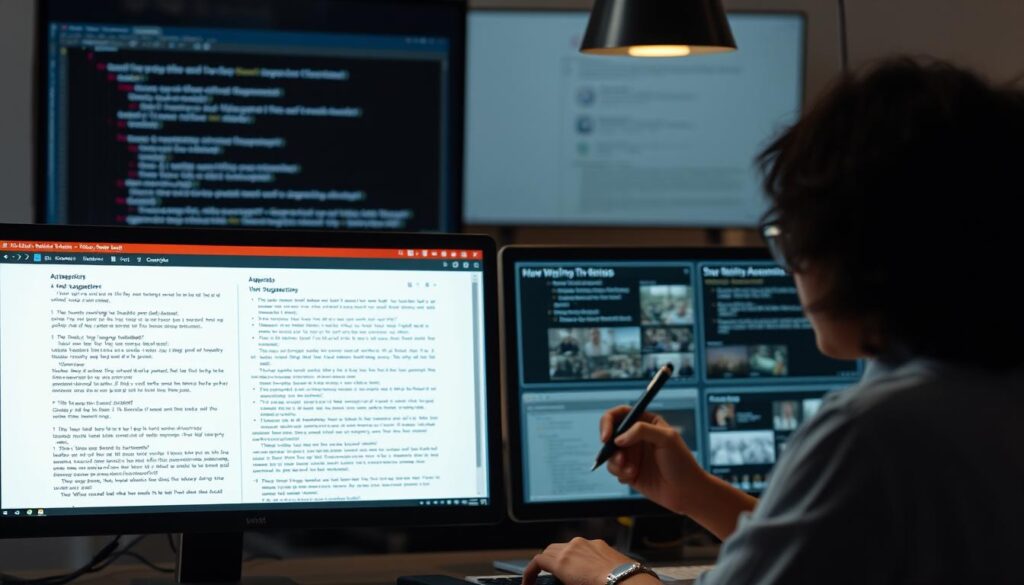
The most effective approach combines AI assistance with human creativity and judgment
Screenwriter Thomas Nguyen summarizes the balance well: “AI is most valuable when it serves as a collaborator rather than a replacement. I use it to expand my thinking, but the final creative decisions—what makes the story uniquely mine—always come from me.”
Case Study: The Robot Scribe Project
To better understand the practical application of AI in scriptwriting, let’s examine a real-world project that deliberately explored the boundaries between human and AI creativity.
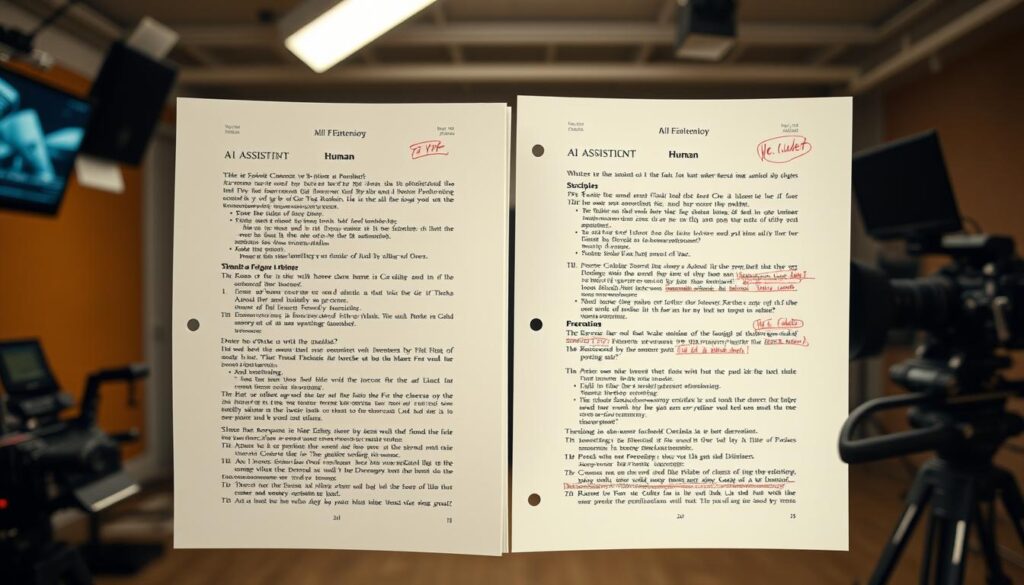
The Robot Scribe Project compared human-written and AI-assisted script sections
In 2023, independent filmmaker Robert Anderson conducted an experiment called “The Robot Scribe” where he attempted to create a screenplay using various AI tools, including ChatGPT, Nolan, and Plotdot. The project aimed to determine whether an AI could write a coherent feature-length screenplay.
The Process
Anderson followed a three-step process that mimicked a traditional screenwriting approach:
- He used ChatGPT to generate a one-sentence pitch and title for a movie about a robot screenwriter
- He then had ChatGPT develop a three-act structure outline for the concept
- Finally, he employed specialized AI screenwriting tools to generate the actual script
The Results
The experiment yielded mixed results. While the AI tools could generate properly formatted screenplay elements and occasionally produce interesting ideas, the final product had significant shortcomings:
AI Strengths
- Proper screenplay formatting
- Basic three-act structure adherence
- Character consistency (though limited)
- Occasional creative scene ideas
- Quick generation of content
AI Weaknesses
- Lack of emotional depth
- Predictable, clichéd dialogue
- Confused narrative logic
- Character motivations poorly developed
- Inability to maintain complex plot threads
Anderson concluded: “AI isn’t the solution to writer’s block. The solution has been and always will be human. Writer’s block isn’t something that you should try to solve with a tool. It’s something you work past to produce better work.”
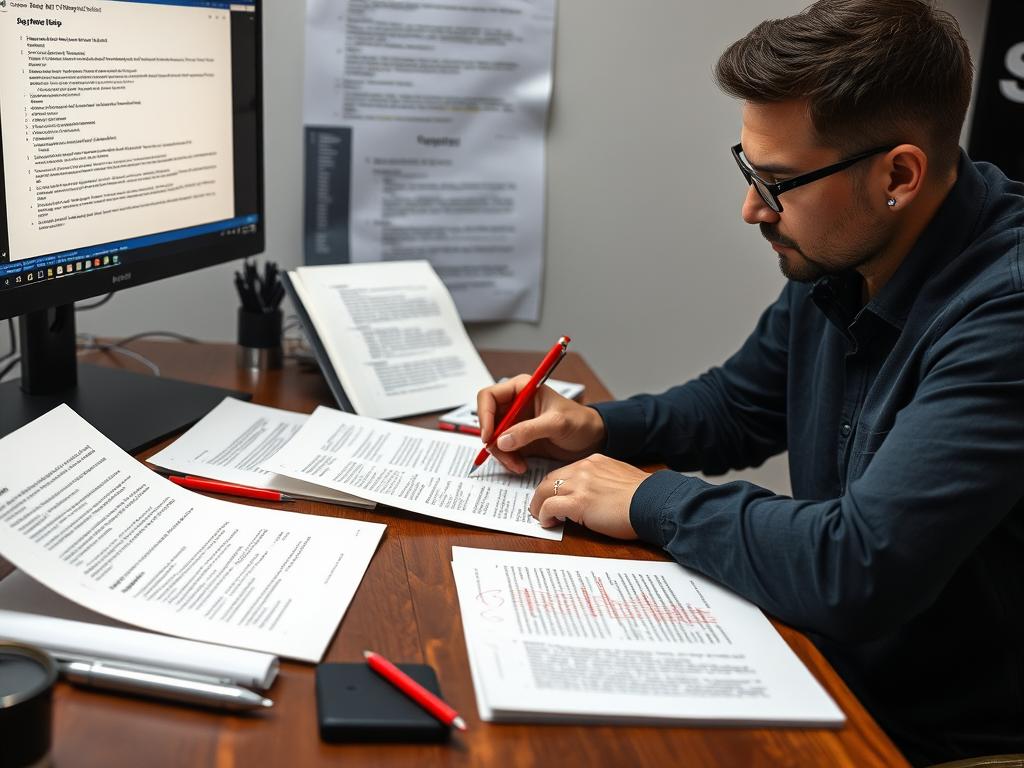
Human editing and refinement remains essential for AI-generated content
This case study highlights a crucial insight: AI tools currently function best as assistants rather than replacements. They can help generate ideas, overcome creative blocks, and streamline certain aspects of the writing process, but the human element—the emotional resonance, narrative coherence, and artistic vision—remains irreplaceable.
Practical Applications: How to Use AI in Your Scriptwriting
For screenwriters interested in exploring AI tools, here are practical ways to incorporate them into your creative process without sacrificing quality or originality:

AI tools can be particularly valuable during the brainstorming phase
Brainstorming and Ideation
AI excels at generating possibilities. When you’re starting a new project or stuck on a concept, try these approaches:
- Ask ChatGPT to generate 10 different logline variations based on your core concept
- Request alternative settings or time periods for your story to consider fresh angles
- Explore “what if” scenarios to test how different premises might play out
Character Development
Develop richer, more nuanced characters with these AI-assisted techniques:
- Generate detailed backstories for secondary characters
- Create character questionnaires and have AI provide potential responses
- Explore character motivations from multiple perspectives
- Test how characters might react in situations not included in your script

AI can help map complex character relationships and dynamics
Dialogue Enhancement
Refine your dialogue with these AI approaches:
- Generate alternative dialogue options for key scenes
- Ask AI to rewrite dialogue in different tones or styles
- Check for consistency in character voices across scenes
- Test how dialogue might change under different emotional circumstances
Structure and Pacing
Strengthen your script’s architecture:
- Have AI analyze your script for adherence to three-act structure
- Identify potential pacing issues or narrative gaps
- Generate alternative scene sequences to test different story flows
- Create beat sheets for complex sequences
“I use AI as a sounding board, not as a writer. I might ask it to generate ten ways a scene could end, knowing I’ll probably use none of them directly—but the exercise often reveals possibilities I hadn’t considered.”
Industry Perspective: What Professionals Are Saying
The film and television industry has responded to AI scriptwriting tools with a mix of curiosity, enthusiasm, and concern. Understanding these perspectives helps contextualize how these tools might shape the future of storytelling.

Industry professionals continue to debate the role of AI in creative writing
Writers Guild of America (WGA) Position
The WGA has taken a clear stance on AI in scriptwriting, particularly following their 2023 strike. Key points from their position include:
- AI-generated material cannot be used as source material
- Writers can use AI tools for personal brainstorming and inspiration
- Companies cannot require writers to use AI software
- Writers must disclose if they use AI tools in their process
- AI cannot be used to undermine writers’ credits or compensation
As Beverly Nault notes in her analysis: “The WGA has expressed concerns about the use of AI in screenwriting, particularly regarding issues of credit and compensation. They’ve taken a strong stance against studios using AI-generated material without proper crediting or compensation to human writers.”
Studio and Production Company Approaches
Major studios and production companies are exploring AI’s potential while navigating the ethical and legal considerations:
- Some studios are developing proprietary AI tools for internal use
- Production companies are using AI for script analysis and market potential assessment
- Independent producers see AI as a way to reduce development costs
- Most maintain that human creativity remains central to the process

Many productions are finding ways to integrate AI tools alongside traditional methods
Independent Filmmakers and Writers
Independent creators often have more flexibility to experiment with AI tools:
- Many use AI to stretch limited resources during development
- Some see AI as democratizing access to scriptwriting assistance
- Others express concern about potential homogenization of creative voices
- Most emphasize using AI as a supplement to, not replacement for, human creativity
As Victoria Brooks explains from her experience: “I see value in working with AI as a collaborator and not as a writer. I write all my own scenes and develop all my own concepts, structure, themes, and dialogue. I love the creativity of figuring out the initial story development on my own.”
Future Outlook: The Evolving Relationship Between AI and Scriptwriting
As AI technology continues to advance, its role in scriptwriting will likely evolve in several key directions:
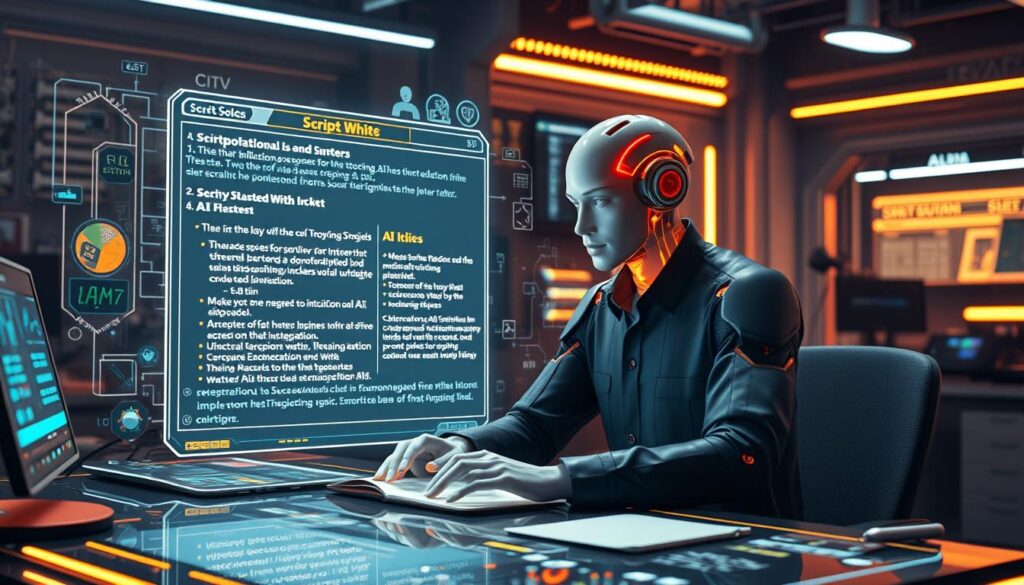
The future likely holds more sophisticated AI-human creative partnerships
Personalized Content Generation
Future AI tools may be able to generate content tailored to specific audience demographics or preferences. This could enable more targeted storytelling and potentially open new markets for personalized entertainment experiences.
Interactive Storytelling
AI could facilitate more sophisticated interactive narratives where viewer choices influence story development in real-time. This convergence of gaming and traditional storytelling could create entirely new entertainment formats.
Enhanced Collaborative Tools
We’re likely to see more specialized AI tools designed specifically for writers’ rooms and collaborative scriptwriting environments, helping teams work more efficiently while maintaining creative cohesion.

Future AI tools may offer more sophisticated analysis and collaboration features
Job Displacement Concerns
While some fear AI will replace human writers, most industry experts predict a shift in roles rather than wholesale replacement. Writers may need to develop new skills to work effectively with AI tools, but the human creative element remains essential for compelling storytelling.
As Robert Anderson concludes in his analysis: “What I am afraid of are the humans so eager to replace an artform. Nothing I did in this article required AI, and I’m as amateur as they come… AI isn’t the solution to writer’s block. The solution has been and always will be human.”
Frequently Asked Questions
Can AI replace human screenwriters?
Current AI technology cannot fully replace human screenwriters. While AI can generate formatted content and assist with certain aspects of the writing process, it lacks the emotional intelligence, lived experience, and creative vision that human writers bring to storytelling. AI is best viewed as a collaborative tool that can enhance human creativity rather than replace it.
Is it ethical to use AI for scriptwriting?
The ethics of using AI in scriptwriting depend largely on how it’s used. Using AI as a brainstorming tool or assistant while maintaining creative control and transparency about its use is generally considered ethical. However, passing off AI-generated content as entirely human-created or using AI to circumvent fair compensation for writers raises significant ethical concerns.
What AI tools are best for scriptwriters?
General AI tools like ChatGPT and Claude are useful for brainstorming and dialogue generation, while specialized tools like Plotdot and Nolan offer more screenplay-specific features. The “best” tool depends on your specific needs, but most professional writers recommend using these tools selectively rather than relying on them for complete script generation.
Conclusion: Finding Balance in the AI Scriptwriting Revolution
The integration of AI into scriptwriting represents neither a creative apocalypse nor a magical solution to all writing challenges. Instead, it offers a new set of tools that can enhance the creative process when used thoughtfully and intentionally.

The most successful approach combines traditional craft with strategic AI assistance
As we’ve seen through industry perspectives and case studies, AI tools like ChatGPT can serve as valuable collaborators—generating ideas, overcoming creative blocks, and streamlining certain aspects of the writing process. However, the human elements of storytelling—emotional resonance, cultural understanding, and artistic vision—remain irreplaceable.
The future of scriptwriting likely lies not in choosing between human creativity and artificial intelligence, but in finding the optimal balance between them. By understanding both the capabilities and limitations of AI tools, writers can harness their potential while preserving the uniquely human qualities that make stories worth telling.
As the technology continues to evolve, so too will the relationship between writers and AI. Those who approach this evolution with curiosity, critical thinking, and a commitment to their craft will be best positioned to thrive in this new creative landscape.
Stay Updated on AI Scriptwriting Developments
Join our community of forward-thinking screenwriters exploring the intersection of AI and storytelling. Receive monthly insights, tutorials, and case studies on how to effectively integrate AI tools into your creative process.







